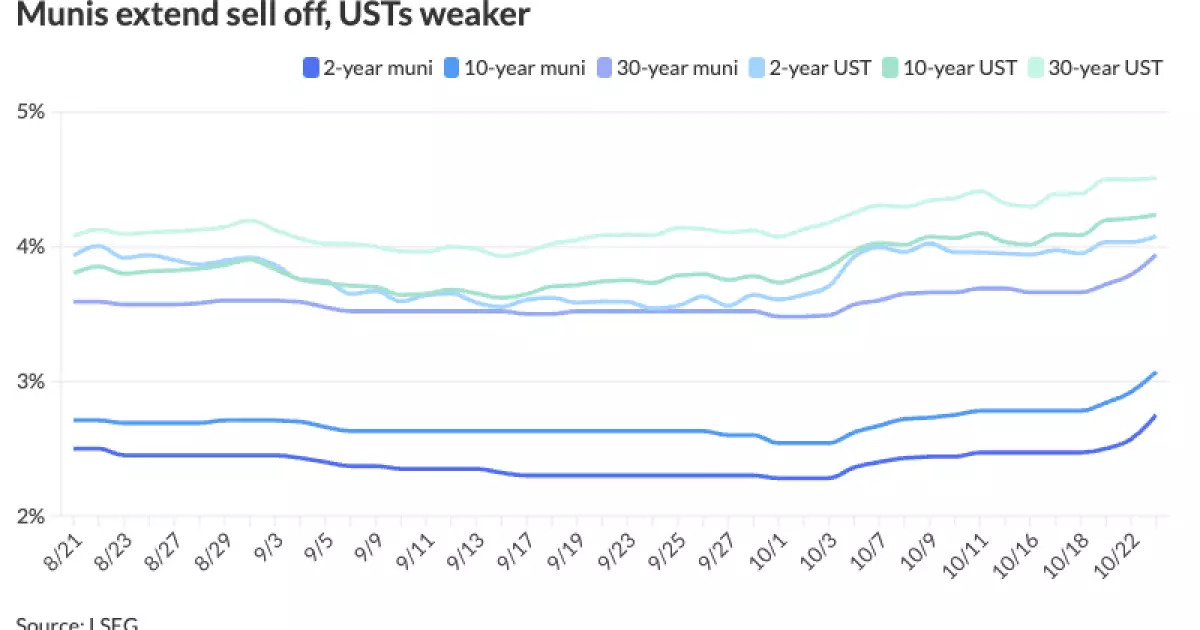The municipal bond market experienced significant volatility recently, with yields sharply increasing as the asset class adjusted to the movement in U.S. Treasury rates. This market correction has raised questions about the sustainability of previous gains in municipal securities, particularly as recent trading patterns reflected an overvaluation of municipals relative to Treasuries. In this article, we will explore the implications of these changes, the factors driving them, and the potential future of the municipal bond market.
On a recent Wednesday, municipal yields surged, reflecting an increase of five to 18 basis points. Notably, the 10-year municipal yield surpassed 3% for the first time since early July. This sharp uptick in yield follows a period of outperformance in the municipal market, leading to ratios that many analysts deemed too high. The recent adjustments show how tightly linked municipal and Treasury yields are; with Treasuries rising steadily over several weeks, municipals had initially lagged behind, prompting a necessary recalibration.
Analysts point to significant shifts in the municipal-to-U.S. Treasury yield ratios as a sign of the changing landscape. For instance, the twinning of ratios for two-year and three-year securities at around 67% indicates a notable disparity, while longer-term securities, such as 30-year bonds, rose to 87%. Such shifts underline the breadth of repricing that has occurred within the municipal landscape.
The recent upheaval in municipal bonds can also be attributed to broader market sentiments. Deteriorating political factors and macroeconomic conditions have left investors skittish. The possibility of a Republican majority in upcoming elections raises apprehensions about future fiscal policy, igniting worries over inflation and deficit spending. As a result, some financial strategists have noted a keen decrease in secondary market liquidity for municipals, constraining investor confidence.
These political uncertainties manifest further in supply dynamics. Many issuers are advancing their fundraising efforts, eager to secure funding amidst the looming policy unpredictability. This acceleration in supply coincides with previously rich municipal-to-Treasury ratios, ultimately leading to the rapid repricing of the market segments.
Insight from experts like Kim Olsan at NewSquare Capital reveals that the failure to transact in the primary market last week allowed for a substantial reset. Olsan posits that the current unwillingness to invest has contributed to an undesirable buildup of cash reserves. According to her, the rise in dealer inventories and bid-wanted counts indicates a bearish performance trajectory in the near term.
In contrast, James Pruskowski from 16Rock Asset Management emphasizes that the fallout from a potential Republican victory could prompt a reawakening of capital flow into the market. This shift could lead to a reexamination of investment opportunities, particularly with newly priced benchmark yields becoming more attractive.
Analyzing Flow Trends in Municipal Bond Funds
Despite the tumultuous market environment, recent inflows into municipal bond mutual funds have been noteworthy. The Investment Company Institute reported $1.524 billion moving into these funds for the week ending October 16, marking 11 consecutive weeks of inflows. Such consistent investment trends contrast sharply with volatility across other markets, suggesting that there remains a substantive belief in the value proposition of municipals, even amidst rising yields.
Moreover, the demand for exchange-traded funds (ETFs) has substantially increased, evidenced by inflows of $1.205 billion following a week of outflows. This strong interest from both retail and institutional investors could signify an underlying resilience in the municipal market, reflecting confidence that the recent correction will ultimately present favorable buying opportunities.
Looking Ahead: Challenges and Opportunities
The path forward for municipals remains fraught with challenges. As J.P. Morgan’s analysts note, continued selling pressure in Treasury markets will likely exert upward pressure on municipal yields. The prevailing sentiment suggests that the market may witness additional repricing efforts due to the influx of new issues coming to market and a focus on more favorable yield levels.
Yet, this environment also presents clear avenues for investment. Analysts like Jeff Timlin of Sage Advisory appear bullish, indicating that once the current wave of adjustments stabilizes, fresh capital investment is likely to lead to a robust market rebound.
While the municipal bond market faces immediate challenges resulting from rising yields and political uncertainties, the underlying demand signals and historical performance trends suggest a compelling narrative for longer-term investment strategies. As investors navigate these dynamic conditions, the municipal market may very well offer a judicious blend of risk and reward for those prepared to capitalize on upcoming opportunities.


Leave a Reply